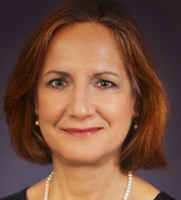We Weren't Prepared For CAR-T: Lessons From An Industry Executive

By Louis Garguilo, Chief Editor, Outsourced Pharma

Joanne Beck, Executive Vice President of Global Pharmaceutical Development and Operations at Celgene, former Senior Vice President of Pharmaceutical Development at Shire, and who has held leadership positions at Abbott, Genentech, and Amgen, has a lot to say about CAR-T cell therapies. Here’s some of it.
Were We Asleep?
Beck is a positive person with a great sense of humor, both of which add credence to the points she made regarding CAR-T at the recent DCAT Week ’18, sponsored by the Drug, Chemical & Associated Technologies Association (DCAT).
In effect, she says what has needed to be said more clearly than it has: With CAR-T, the future arrived, and we weren’t ready for it.
 “I feel the biopharma industry was far behind on the process and analytical development and manufacturing technology side with CAR-T,” she says evenly. “So we’re scrambling. If you look at where we should be to make CAR-T accessible and affordable, we don’t have enough automation, the analytics is behind, and we haven’t developed ready-to-use data systems. The supply chain is still immature – we’re struggling with the patient and cell journey. Vector capacity is super low, and everybody’s struggling to get vector-supply accessible. A lot of the raw materials used in CAR-T are single sourced.”
“I feel the biopharma industry was far behind on the process and analytical development and manufacturing technology side with CAR-T,” she says evenly. “So we’re scrambling. If you look at where we should be to make CAR-T accessible and affordable, we don’t have enough automation, the analytics is behind, and we haven’t developed ready-to-use data systems. The supply chain is still immature – we’re struggling with the patient and cell journey. Vector capacity is super low, and everybody’s struggling to get vector-supply accessible. A lot of the raw materials used in CAR-T are single sourced.”
“So,” she asks, now in a more nuanced voice, “Were we asleep?”
“Why weren’t we preparing for this?” she continues. One reason she offers is the risk involved in investing in something that hasn’t proven to be successful or profitable in the market. Still, says Beck, “There has to be some sort of risk-sharing path, where we can prepare ourselves for these new disruptive technologies that are coming … and they are coming.”
The pace at which disruptive technologies are being developed and brought to the manufacturing environment in various industries around the globe is “increasing tremendously,” and thus, the biopharma industry should “develop discipline around how we monitor the external world for what technologies are emerging.”
“We need to assess new technologies on a regular cycle,” says Beck. “Look around, aggregate the new ideas, do some analysis, pick those we think are going to hit, and then start working to implement them.”
CAR-T Promise, Challenge And Partners
The promise of CAR-T, and cell therapy in general, is immense. With these therapies, cells are taken from the patient at an apheresis center, shipped to a central manufacturing location to be transduced with a vector, and expanded. The drug product is then isolated and sent back to the patient for infusion.
It’s a difficult supply-chain challenge, but part of the excitement for the industry is “this ultimate form of personalized medicine,” says Beck. “Each ‘batch’ is one patient. It’s a scientist’s or chemical engineer’s dream … However, it’s still a bit of a supply-chain professional’s nightmare.”
The time it takes to acquire the amount of cells to make the drug effective enough to infuse back into the patient is one challenge. Once a physician identifies a patient who is then approved to receive a particular CAR-T therapy, the concern then turns to whether there is a manufacturing spot immediately available.
“In the meantime,” says Beck, using a phrase she often intones, “The patient is waiting.”
Now with the acquisition of Juno Therapeutics, Celgene has additional capability in process, analytical, and digital technology development for CAR-T. However, says Beck, “External partners can play a key role to augment internal capability and capacity.”
“The challenge for the pharmaceutical industry – across all our supply chain partners, CDMOs and CMOs – is the capabilities. All the divergent platforms require different capabilities and skill sets that are not in abundance out there.”
Beck continues: “We do not have many people with experience or who are really competent at this point. One of the biggest challenges is identifying and building competency in-house, and also with our partners, in all these different areas of cell therapy. Bioassays, potency assays, automation – there’s a capability and skill gap we’re facing. It’s difficult for us to build all this internally. We have to look for reliable partners externally.”
Beck says Celgene’s best partners have strong analytical groups, but this is an area where it’s experiencing significant skill gaps. Having to move from one place for the manufacturing, and several others to outsource analytical methods for a process or even in-process testing, further complicates an already complicated supply chain.
Celgene also looks to academic centers for developing certain “bridging technologies” the company may not be able to develop or that traditional CDMO partners are not able to help with. “But then,” says Beck, “we need that additional time and expertise to transfer the technologies to where they can be commercialized.”
New Locations
When it comes to searching for new locations to establish these needed capabilities and capacities, Beck says it starts with the two aspects of CAR-T (and other cell and gene therapies).
First, vector manufacturing can be located without “strict location parameters,” although Celgene prefers to put manufacturing near their existing facilities to leverage infrastructure.
For the actual drug product manufacturing – the process to take the cells, transduce and grow them – Celgene currently sticks to a “centralized manufacturing model.” The company now has facilities on both coasts: Juno’s manufacturing plant in Bothell, WA, and Celgene’s cell therapy facility in Warren, NJ, as well as a brand new facility in Summit, NJ. Beck mentions that Celgene is also looking around Europe, and potentially other countries, for additional capacity/capability infrastructure.
Within any initial new search for a global location, “the realization of the supply chain takes precedent.” Celgene looks for access by air, but also all other means of transportation.
“If we have a centralized manufacturing model, we must be extremely fast in getting the patients’ cells from the apheresis centers to the manufacturing facilities, and then back to all the clinics where the patients are being treated.”
In short, it’s all about geographic access, and what Beck calls “our needed tasks.”
“Processes are very manual right now,” she says. “We’re looking for areas where we can hire a fairly large workforce. Areas with experienced manufacturing personnel, and where there are training programs we can access to train inexperienced hires.”
Regarding outsourcing, Celgene looks for partners with specific experience – “Not somebody that’s cutting their teeth” – and for “someone that has a long-term purpose in this specific area. They really want to build these capabilities.”
So with CAR-T, the biopharma industry was behind the proverbial eight ball. Celgene and others are now doing an admirable job in catching up. And Beck is personally determined to also get ahead of the next new thing coming along.
After all, patients are waiting.
